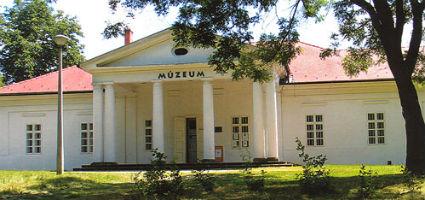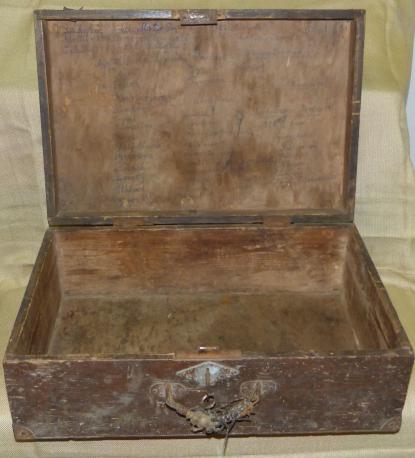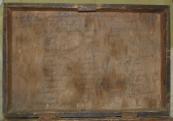2024. May 3. Friday
Pál Kiss Museum - Tiszafüred
 |
Address: 5350, Tiszafüred Tariczky sétány 6.
Phone number: (59) 352-106
E-mail: kisspalmuz@gmail.com
Opening hours: Tue-Sat 9-12, 13-17
|
The exhibition has closed for visitors.
2015.02.02. - 2015.02.28.
Museum tickets, service costs:
|
Ticket for adults
|
500 HUF
|
/ capita
|
|
Group ticket for adults
(min. 10 people)
|
150 HUF
|
/ capita
|
|
Ticket for students
|
250 HUF
|
/ capita
|
|
Ticket for pensioners
|
250 HUF
|
/ capita
|
|
Ticket for families
(2 adults + max. 3 children)
|
750 HUF
|
/ family
|
|
Program ticket
|
300 HUF
|
/ capita
|
|
Season ticket
|
1000 HUF
|
|
|
Group guide
(max. 40 people)
|
2000 HUF
|
/ group
|
|
Photography
|
1000 HUF
|
|
|
Video
|
1000 HUF
|
This month we display an old, weather-beaten box-like object, coloured dark.brown. It is a footlocker from the World War II and it was used by a Hungarian soldier who had been a war prisoner of the GULAG in the Soviet Union for 11-12 years (from 1944 till 1956). He was Lajos Mester (Mikruszko), who lived in our town in Tiszafüred (1922-2008).

The GULAG is the anocrym of the forced labour camp system for the enemy of communist system (from petty criminals to political or war prisoners). These camps existed from 1930 till 1953 (or 1960!), during the Stalin era all over the Soviet Union and their number is estimated as 430-450. It was the Russian novelist Aleksander Solzhenitsyn (1918-2008) who had raised global awareness on the gulag (and was awarded the Nobel Prize in Literature in 1970 for this)
We can study the list of stops, the names of towns passed during Mester Lajos's journey to the forced labour camp. It was Lajos Mester who had put down this list. The box was made by an other war prisoner for the owner. Lajos Mester had lived in Tiszafüred before he had became a soldier in the Hungarian Army and had fougth against th Soviet Red Army during the World War II. He had been captured and first he had been senteced to death but he had got Stalin's pardon: sentenced to forced labour camp for up to 20 years.
That is why he had been taken to Siberia, to Novaja Zemlja. As the manuscript says this „suitcase had been made in 1946, in Russia, in Novaja Zemlja Then in Norilszk from 1946 till 1953. Then Sziberija, Tajset, Irkutszk, Krasznojarksz, Kemerovo, Tomszk, Novoszibér, Omszk, Cseljabinszk, Szverdlovszk, Kánszk, Gomel, Ukka, Moszkva!!, Dudinka, Igarka, Tunguzka, Ukrajina, Kijev!, Hárkov, Kaminec Podolszki, Zsitomer, Korosztin Zsanfov, Odessza, Kaminec Podolszki, Dnyitropetrovszkaja, Poljtava, Minszk, Szmolenszk, Poland, Cseszkó (! - it is Czecho-Slovakia) Romanija. Then Hungary 1956. III. 3. Nyíregyháza, Jászberény, Budapest, Debrecen, Füzesabony, Karcag Tilalmas ÁG, Tiszafüred, Szentes”.
We think this list is not an exact order of the travelling as it must have been put down later as the yourney was. But this suitcase is a symbol, a relict of a victim of the communism. Mester Lajos survived the GULAG and the period of communism and he was a tremelous person for up to his lifetime. Altough Zsolt Csalog, the Hungarian sociologist had published a book on his life with the tilte M. Lajos , Aged 42 in 1989, Mester Lajos had never told his experiences to the wider public. Neither after the political changes from 1989 though he had died after the year 2000.

The GULAG is the anocrym of the forced labour camp system for the enemy of communist system (from petty criminals to political or war prisoners). These camps existed from 1930 till 1953 (or 1960!), during the Stalin era all over the Soviet Union and their number is estimated as 430-450. It was the Russian novelist Aleksander Solzhenitsyn (1918-2008) who had raised global awareness on the gulag (and was awarded the Nobel Prize in Literature in 1970 for this)
We can study the list of stops, the names of towns passed during Mester Lajos's journey to the forced labour camp. It was Lajos Mester who had put down this list. The box was made by an other war prisoner for the owner. Lajos Mester had lived in Tiszafüred before he had became a soldier in the Hungarian Army and had fougth against th Soviet Red Army during the World War II. He had been captured and first he had been senteced to death but he had got Stalin's pardon: sentenced to forced labour camp for up to 20 years.
That is why he had been taken to Siberia, to Novaja Zemlja. As the manuscript says this „suitcase had been made in 1946, in Russia, in Novaja Zemlja Then in Norilszk from 1946 till 1953. Then Sziberija, Tajset, Irkutszk, Krasznojarksz, Kemerovo, Tomszk, Novoszibér, Omszk, Cseljabinszk, Szverdlovszk, Kánszk, Gomel, Ukka, Moszkva!!, Dudinka, Igarka, Tunguzka, Ukrajina, Kijev!, Hárkov, Kaminec Podolszki, Zsitomer, Korosztin Zsanfov, Odessza, Kaminec Podolszki, Dnyitropetrovszkaja, Poljtava, Minszk, Szmolenszk, Poland, Cseszkó (! - it is Czecho-Slovakia) Romanija. Then Hungary 1956. III. 3. Nyíregyháza, Jászberény, Budapest, Debrecen, Füzesabony, Karcag Tilalmas ÁG, Tiszafüred, Szentes”.
We think this list is not an exact order of the travelling as it must have been put down later as the yourney was. But this suitcase is a symbol, a relict of a victim of the communism. Mester Lajos survived the GULAG and the period of communism and he was a tremelous person for up to his lifetime. Altough Zsolt Csalog, the Hungarian sociologist had published a book on his life with the tilte M. Lajos , Aged 42 in 1989, Mester Lajos had never told his experiences to the wider public. Neither after the political changes from 1989 though he had died after the year 2000.

